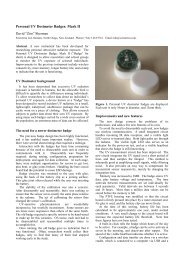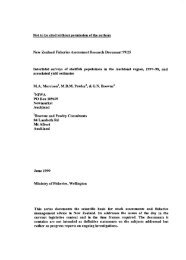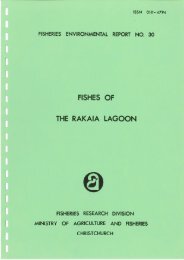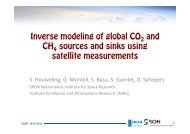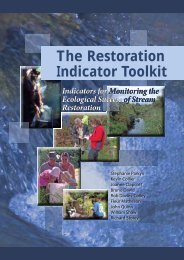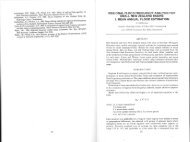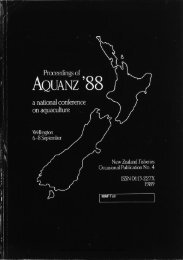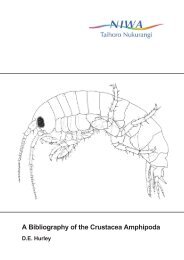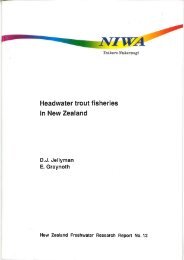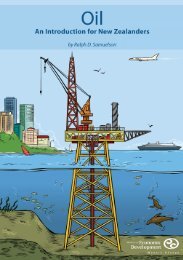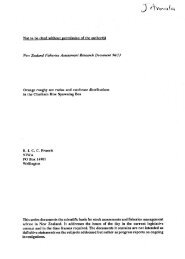WATER & SOIL - These are not the droids you are looking for.
WATER & SOIL - These are not the droids you are looking for.
WATER & SOIL - These are not the droids you are looking for.
Create successful ePaper yourself
Turn your PDF publications into a flip-book with our unique Google optimized e-Paper software.
e.9., Linsley et ol. (1915); lrish and Ashkanasy (1977).<br />
There was, in fact, only one station with more than 20 years<br />
of record. However, <strong>the</strong>se relatively small samples reflect<br />
<strong>the</strong> situation <strong>the</strong> design engineer is often faced with<br />
- having<br />
to estimate design figures from records of b<strong>are</strong>ly adequate<br />
length.<br />
Most of <strong>the</strong> findings of <strong>the</strong> test could only be regarded as<br />
preliminary ones pending fur<strong>the</strong>r investigation with larger<br />
samples and covering a great'Jr part of <strong>the</strong> country. The<br />
findings <strong>are</strong> a guide to <strong>the</strong> design engineer using a small<br />
sample in flood frequency analysis, but <strong>the</strong> test itself was<br />
<strong>not</strong> very helpful in <strong>the</strong> choosing of a distribution <strong>for</strong> <strong>the</strong> regional<br />
curves. A second test was <strong>the</strong>re<strong>for</strong>e carried out at <strong>the</strong><br />
end of <strong>the</strong> data collection phase using larger data samples.<br />
4.4.4 Second test<br />
The second evaluation test used annual series data from<br />
14 stations with 20 or more years of record. Details of <strong>the</strong>se<br />
stations <strong>are</strong> listed in Table 4.3. As shown in <strong>the</strong> table, <strong>the</strong>re<br />
was a total of 366 station years of record, giving an average<br />
record length of 26.1 years per station, almost double <strong>the</strong><br />
figure <strong>for</strong> <strong>the</strong> first test.<br />
The per<strong>for</strong>mances of <strong>the</strong> different methods on <strong>the</strong> second<br />
set of data were evaluated in exactly <strong>the</strong> same manner<br />
as tbr <strong>the</strong> first test. The results of <strong>the</strong> evaluation <strong>are</strong> summarised<br />
in Table A.4.<br />
Table A.4 shows that <strong>the</strong> Jenkinson method again per<strong>for</strong>med<br />
best, but this time <strong>the</strong> Cumbel method gave a pertbrmance<br />
that was almost as good. Notably, nei<strong>the</strong>r<br />
method gave any poor fits to <strong>the</strong> data. At <strong>the</strong> second level<br />
of per<strong>for</strong>mance were <strong>the</strong> GEV and LP3 (unadjusted and<br />
adjusted) methods, all with <strong>the</strong> same score of 22. The per<strong>for</strong>mances<br />
of <strong>the</strong> unadjusted and adjusted LP3 methods<br />
were indistinguishable and <strong>the</strong> two methods <strong>are</strong> collectively<br />
referred to as <strong>the</strong> LP3 method. Last were <strong>the</strong> log-Normal<br />
and EVI methods. Both methods gave good fits at least<br />
5090 of <strong>the</strong> time, but also a <strong>not</strong>iceable percentage (2190) of<br />
poor fits.<br />
As in <strong>the</strong> lirst test, <strong>the</strong> Jenkinson method per<strong>for</strong>med <strong>the</strong><br />
best ot'<strong>the</strong> methods, and in this second test could r<strong>are</strong>ly be<br />
faulted. ln <strong>the</strong> one instance where it gave o<strong>the</strong>r than a good<br />
per<strong>for</strong>mance, its frequency curve still fitted <strong>the</strong> data well<br />
and produced a realistic 100-year flood peak estimate.<br />
However, its per<strong>for</strong>mance was reduced because of its Chisqu<strong>are</strong><br />
value, which was high and more than twice that <strong>for</strong><br />
any of <strong>the</strong> o<strong>the</strong>r methods. Some allowance was always<br />
made <strong>for</strong> a higher Chi-si¡u<strong>are</strong> value with <strong>the</strong> Jenkinson<br />
method, but in this particular case <strong>the</strong> value was excessively<br />
high. The higher values <strong>for</strong> <strong>the</strong> method <strong>are</strong> caused by <strong>the</strong><br />
fact that <strong>the</strong> frequency curve does <strong>not</strong> always fit <strong>the</strong> lowest<br />
four items in a series, since <strong>the</strong>se items clo <strong>not</strong> <strong>for</strong>m part of<br />
<strong>the</strong> generated 5-year maxima to which <strong>the</strong> method fits <strong>the</strong><br />
EVI curve.<br />
The Cumbel method improved on its first test ranking<br />
giving an overall per<strong>for</strong>mance almost <strong>the</strong> same as <strong>the</strong> Jenkinson<br />
method. However, a surprising aspect in both tests<br />
Tabþ 4.3 Details of <strong>the</strong> flow stations used in <strong>the</strong> second evaluation<br />
test.<br />
Site No.<br />
Flow Station<br />
Catchment Record<br />
<strong>are</strong>a, km' Length,<br />
yeafs<br />
14614 Kaituna at Te Matai 958 21<br />
1551 1 Waimana at Waimana Gorge 44O 25<br />
1 5514 Whakatane at Whakatane 1 557 20<br />
29201 Ruamahanga at Wardells 637 22<br />
29202 Ruamahanga at Waihenga 2340 21<br />
29224 Waiohine at Gorge 183 22<br />
32502 Manawatu at Fitzherbert 3916 48<br />
32503 Manawatu at Weber Road 713 22<br />
32514 Oroua at Almadale 312 24<br />
32526 Mangahao at Ballance 266 24<br />
32529 Tiraumea at Ngaturi 734 24<br />
601 14 Wairau at Dip Flat 5O5 25<br />
92216 Buller at Lake Rotoiti 195 26<br />
93213 Gowan at Lake Rotoroa 368 42<br />
366<br />
was <strong>the</strong> difference in per<strong>for</strong>mance between <strong>the</strong> Gumbel and<br />
EVI methods. Both fit <strong>the</strong> same distribution (EVl) to a<br />
series yet <strong>the</strong> EVI method did <strong>not</strong> per<strong>for</strong>m as well, presumably<br />
because <strong>the</strong> ML fitting technique, in comparison with<br />
<strong>the</strong> least-squ<strong>are</strong>s technique, puts relatively greater weight<br />
on <strong>the</strong> smaller items in a data series (Gumbel 1966). Consequently,<br />
if <strong>the</strong> upper half of a series exhibited a different<br />
trend. to that <strong>for</strong> <strong>the</strong> lower half, <strong>the</strong> EVI method, especially,<br />
did <strong>not</strong> always produce a good fit to <strong>the</strong> upper half<br />
and its per<strong>for</strong>mance suffered accordingly. In addition, <strong>the</strong><br />
visual inspection of <strong>the</strong> goodness-of-fit of <strong>the</strong> frequency<br />
curves may have given <strong>the</strong> Gumbel method an unfair advantage<br />
over <strong>the</strong> EVI method, since curve-fitting by eye can<br />
be considered as a least-squ<strong>are</strong>s fit (Chernoff and Lieberman<br />
1954, 1956). Thus, although <strong>the</strong> results may indicate<br />
that <strong>the</strong> Gumbel method may be a worthy substitute <strong>for</strong> <strong>the</strong><br />
Jenkinson method when a computer is unavailable, <strong>the</strong><br />
evaluation may have been weighted unfairly in favour of<br />
<strong>the</strong> Gumbel method.<br />
The methods using three-parameter distributions, i.e.,<br />
<strong>the</strong> LP3 and <strong>the</strong> GEV methods, displayed <strong>the</strong>ir greater flexibility<br />
over <strong>the</strong> two-parameter methods by always producing<br />
a curve that fitted <strong>the</strong> data particularly well. However,<br />
occasionally this was to <strong>the</strong>ir detriment, because <strong>the</strong><br />
resulting 100-year flood peak estimate was sometimes <strong>not</strong><br />
very realistic. For example, in <strong>the</strong> case where <strong>the</strong> LP3<br />
method gave a poor per<strong>for</strong>mance, <strong>the</strong> curve fitted <strong>the</strong> data<br />
very well; so well in fact that it was almost horizontal at <strong>the</strong><br />
high return periods. The difference between <strong>the</strong> 20 and<br />
10O-year flood peaks estimated from <strong>the</strong> curve was less than<br />
0.690, indicating an implausible 10O-year flood peak estimate.<br />
Table A.4 Summary of <strong>the</strong> per<strong>for</strong>mance of <strong>the</strong> methods in <strong>the</strong> second test.<br />
Method<br />
Per<strong>for</strong>mance<br />
Categories<br />
No. 1<br />
LP3<br />
No. 2<br />
Adjusted<br />
LP3<br />
No. 3<br />
Log-Normal<br />
No. 4<br />
GEV<br />
No.5<br />
EV1<br />
No. 6<br />
Gumbel<br />
No. 7<br />
Jenkinson<br />
No Score No. Score No, Score No. Score No. Score No. Score No. Score<br />
Good<br />
Reasonable<br />
Poor<br />
9 18 I 18 9 18 8 16 7 ',t4 12 24 13 26<br />
44442266442211<br />
10103000300000<br />
Total Score<br />
22<br />
22 20 ?2 18 26<br />
27<br />
Note: Maximum possible score = 28<br />
Water & soil technical publication no. 20 (1982)<br />
90



